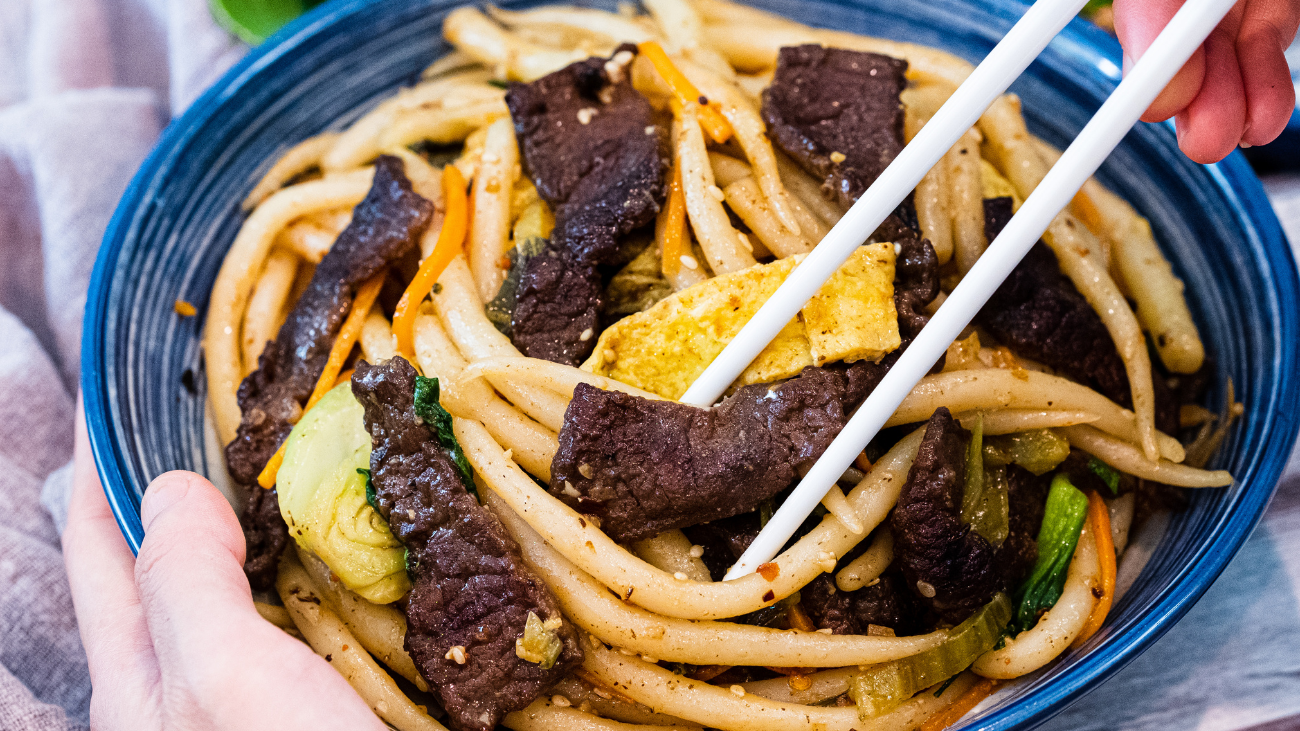Hakka Style Silver Needle Noodles (客家炒银针粉)
Rated 5.0 stars by 1 users
This is one of those recipes that is unknown in the western world but incredible. 银针粉 (yínzhēnfěn) translated as silver needle noodles; they are made with rice flour and tapioca flour, and they have a unique bouncy and chewy texture. If you are a noodle lover, this one should be on your trying list.
Souped Up Recipes

Ingredients
-
250 grams of rice flour
-
80 grams of tapioca starch
-
200 grams of hot water
-
100 grams of room temperature water
-
200 grams of beef, sliced thinly
-
2 tsp of soy sauce
-
½ tsp of dark soy sauce
-
¼ tsp of 5 spice powder
-
¼ tsp of baking soda
-
White pepper to taste
-
A drizzle of cooking oil
-
3-4 tbsp of cooking oil as needed
-
2 whole eggs, beaten well
-
1 tbsp of minced garlic
-
2 tsp of fermented black bean, roughly diced
-
85 grams (3oz) of carrot, julienned
-
4 oz of pickled mustard green, sliced thinly
-
2 baby bok choy, julienned
-
1.5 tbsp of soy sauce
-
1.5 tbsp of oyster sauce
-
White pepper to taste
-
Chili flake to taste
-
2 tsp of toasted sesame seeds
INGREDIENTS FOR MAKING THE RICE NOODLES
INGREDIENTS TO MARINATE THE BEEF
OTHERS, TO COMPLETE THE STIR FRY NOODLES
Directions
Combine the rice flour and tapioca flour thoroughly. Bring 200 grams of water to a boil, then slowly pour it into the flour mixture and stir until well mixed. Cover it and let it cool until lukewarm.
Slowly pour in about 100 grams of room temperature water in batches and knead it until the flour forms into a smooth dough.
Divide the dough into six smaller pieces. Roll each one into a long thin strip. Line all the strips together and roughly cut them into bite-size pieces (10-12 grams each).
Shape those bite-size dough pieces into pointy needle noodles by rolling them back and forth. It sounds time-consuming, but it only takes 10-15 minutes to roll out all the noodles. It is ok to pile up all the noodles together as long as you made the dough non-stick. Once you put them into the boiling water, they will separate right away.
Bring 3 liters of water to a boil and add the noodles. Do not stir immediately. Give it a minute for the starch to set; then, you can stir so the noodles cook evenly.
If you eat the noodles right away, continue to cook for 2-3 minutes after the noodles float to the top of the water. If you are going to use the noodles as an ingredient to make stir fry noodles, continue to cook for 1-2 minutes after the noodles float.
Take the noodles out and transfer them into the ice bath to firm up the texture. Leave the noodles in there while preparing the ingredients for the stir fry noodles.
Cut the beef into 1/8 of an inch thick slices, then marinate with soy sauce, dark soy sauce, five-spice powder, baking soda, and vegetable oil. Set aside for 15 minutes.
Cut the stem part of the baby bok choy smaller and the leaves part bigger. Separate the leaves and the stem because they take different time to cook
Drain the silver needle noodles completely; Then season with oyster sauce, soy sauce, and some white pepper to taste.
Heat your wok until smoking hot. Add oil (1.5 tbsp) and swirl it around. Pour in the beaten egg. Swirl the wok again so the egg can cover the bottom of the pan. Once most of the egg is set. Flip it over and cook the other side for 10 seconds. Take it out and cut it into egg noodles. Set it aside.
Turn the heat back on high. Add more oil and heat it until smoking hot. Stir the beef until the color is changed; remove to the side. Make sure you tilt the wok to leave the excess oil behind.
Add the minced garlic, diced fermented black beans, sliced pickled mustard green, julienne carrot, and the bok choy stems. Stir over medium heat for a couple of minutes. The pickled mustard green is salty already, so you don’t need to season these vegetables. However, if you didn’t use any salty pickles, you may need to sprinkle some salt here.
Add the well-drained silver needle noodles, cooked beef, egg, and the leafy part of the baby bok choy to the wok. Stir over high heat until the bok choy is soft and the noodles are heated up.
Before serving, sprinkle some chili flakes and toasted sesame seeds to taste.



































